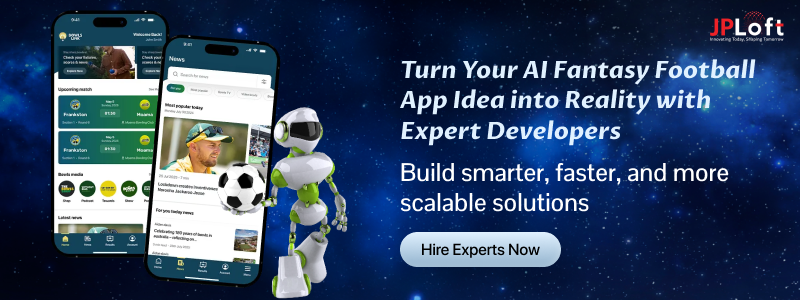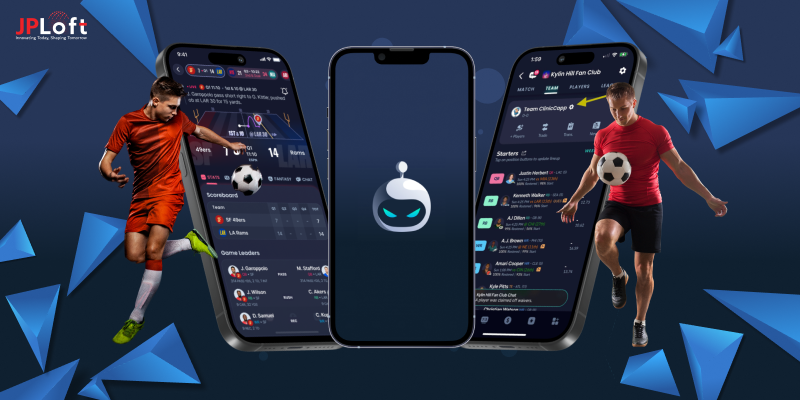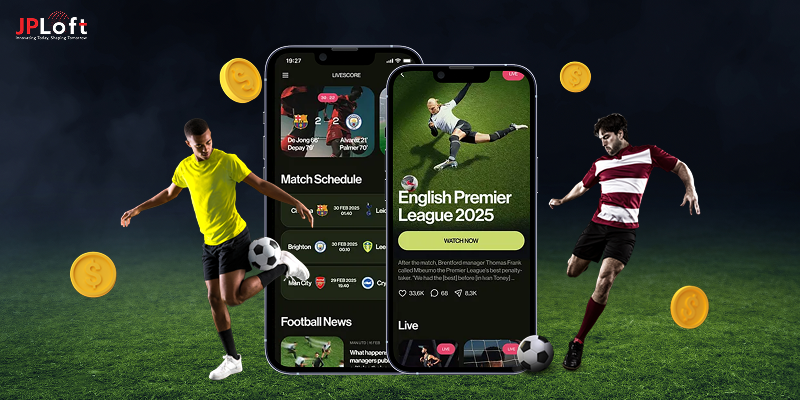“Opportunities don’t happen. You create them.” — Chris Grosser.
The fantasy sports industry is living proof of this, with innovation shaping billion-dollar opportunities.
Among the standout names is RotoBot AI, an AI-powered fantasy football assistant that transforms how players make decisions by offering personalized, data-driven recommendations.
Unlike traditional guides, it syncs with leagues, evaluates matchups, and even answers natural language questions, setting a new standard for user experience.
For entrepreneurs and startups eyeing this space, the question arises: what’s the cost to build an AI fantasy football app like RotoBot AI? The answer typically ranges from $30,000 to $120,000, depending on the features, AI complexity, design, and long-term maintenance you choose to invest in.
In this blog, we’ll break down the cost factors, explain monetization strategies, and highlight how to make smart choices that ensure your app stands out in the rapidly growing fantasy sports market.
An Overview of RotoBot AI App
Before you learn about the cost to create an AI fantasy football app like RotoBot AI, let’s learn about the app.
RotoBot AI is a groundbreaking fantasy football assistance app that applies artificial intelligence to automate decision-making for players.
RotoBot AI is different from other traditional fantasy guides that merely display projections since it offers individualized suggestions based on your league settings, roster, and rules of scoring. It is possible to sync fantasy leagues from websites such as ESPN or Sleeper and immediately get AI-based suggestions on whom to start, sit, trade, or waive.
The app extends beyond numbers with each recommendation supported by clear explanations based on player statistics, injuries, matchups, and even deep playoff implications. Its chatbot UI lets users pose natural questions such as "Should I start Player A or Player B?" and receive quick, data-driven replies.
With its advanced data models combined with easy-to-use functionality, RotoBot AI enables fantasy football managers to get an edge, make better decisions, and have a more competitive fantasy experience every week.
Let’s learn about the fantasy sports market stats to know why you need to invest in it.
-
The Global fantasy sports market size was estimated at USD 24,853.7 million in 2024, and is projected to reach USD 56,381.2 million by 2030, growing at a CAGR of 15.2%.
-
The market size of the fantasy sports app has reached USD 37.28 billion in 2025, and is projected to hit USD 71.24 billion by 2030.
-
Additionally, when you look forward to the AI-powered fantasy football platform like RotoBot AI, it is available on the Apple App Store with 4.6/5 user reviews, and the official site lists ratings: App store 4.7, and Google Play: 4.8.
With the growing ratings on the platforms, deciding to build an AI fantasy football app like RotoBot AI automatically develops a great opportunity to enter the market. And to turn this opportunity into reality, the next step is to evaluate the overall cost involved in building such an app.
Cost to Create an AI Fantasy Football App like RotoBot AI
The overall cost to create an AI fantasy football app like RotoBot AI varies between $30,000 $120,000.
Creating an AI fantasy football app like RotoBot AI requires strategic planning, strong technical expertise, and a focus on delivering personalized experiences.
The investment isn’t just about development but also ensuring scalability, seamless performance, and long-term user engagement that makes the app competitive in the growing fantasy sports market.
The cost to develop a fantasy football app further breaks down due to different drivers, such as features, complexity of the app, tech stack, design, and many others.
|
Cost Driver |
Details |
Estimated Cost Range |
|
Basic Features |
User registration, team creation, scoring system, leaderboards |
$8,000 – $15,000 |
|
Advanced Features |
AI-driven recommendations, live stats integration, predictive analytics |
$12,000 – $25,000 |
|
App Complexity |
Single-platform (iOS/Android) vs. cross-platform, number of modules |
$10,000 – $20,000 |
|
Tech Stack & Integrations |
APIs for sports data, AI/ML frameworks, cloud infrastructure |
$8,000 – $18,000 |
|
UI/UX Design |
Interactive dashboards, responsive layouts, custom graphics |
$5,000 – $12,000 |
|
Testing & QA |
Performance, security, and usability testing across devices |
$3,000 – $8,000 |
|
Post-Launch Support |
Maintenance, updates, and scalability improvements |
$4,000 – $10,000 |
Let’s learn about the cost drivers in the following section.
Factors Impacting the Complete Cost to Build a Smart App like RotoBot AI
How to develop a fantasy football app? This question can be answered only if you know the overall cost.
When you decide the cost to create an AI fantasy football app, one of the issues that might bother you is the cost drivers.
But, not anymore, in the given section, you will find all the cost drivers impacting the complete cost to develop a fantasy football-like RotoBot AI.
1. App Features and Scope
The depth of features directly impacts development costs. A simple MVP with core functions like team sync, lineup optimization, and projections sits at the lower range.
The fantasy football app features directly influence user experience, development cost, and market positioning.
Adding advanced tools such as trade analyzers, waiver assistants, and AI-powered chatbots significantly raises costs to create an AI fantasy football app like Rotbot AI, due to complexity and integrations.
|
Scope |
Estimated Cost |
|
Basic MVP |
$30,000–$45,000 |
|
Advanced Features |
$60,000–$90,000 |
2. AI & Machine Learning Integration
Building and training AI models for predictions, lineup optimization, and trade evaluations requires specialized expertise, which partnering with an AI app development company can provide.
AI is one of the important scopes of fantasy football apps like RotoBot AI. You can minimize the cost here and provide personalized suggestions to the target users.
Costs rise with the need for large datasets, ML pipelines, and explainable AI models. More advanced personalization features with predictive analytics push development closer to the higher end of the spectrum.
|
AI Depth |
Estimated Cost |
|
Basic Predictions |
$35,000–$60,000 |
|
Advanced AI Models |
$80,000–$120,000 |
3. Design and User Experience (UX/UI)
A clean, intuitive design is essential for fantasy players. Costs depend on whether you build a simple template-based UI or a custom design with animations, dashboards, and interactive elements. You can create the mobile app wireframe and prototype to get a user-centric design apt for your project.
Good UX reduces churn and makes the app competitive, but increases design hours and budget. The fantasy football app design should be simple and user-centric to provide users with what they are actually seeking in this competitive era.
Let’s evaluate the complete cost table for the design factor.
|
Design Level |
Estimated Cost |
|
Basic UI |
$5,000–$10,000 |
|
Custom UX/UI |
$20,000–$40,000 |
4. Platform Choice (iOS, Android, Web)
Developing for one platform costs less, but multi-platform support increases expenses. Whether it's about submitting an iOS app to the App Store or it's about publishing an Android app on the Play Store, you should know the process and its requirements.
When it's about analysing the cost to build an AI fantasy football app like RotoBot AI, it's essential to know the right audience, who are interested in such an app, and then to select the platform accordingly.
Cross-platform frameworks like React Native save money, while separate native apps cost more but offer better performance, especially for heavy data processing and live updates in fantasy sports.
|
Platforms |
Estimated Cost |
|
Single Platform |
$30,000–$50,000 |
|
Multi-Platform |
$70,000–$120,000 |
5. Backend Development & APIs
A fantasy app requires a strong backend for data syncing, AI model execution, user management, and notifications.
The fantasy football app tech stack does impact the overall cost figure. Here, the tech stack should be robust and scalable for managing and handling real-time user traffic.
The cost depends on whether you’re using third-party APIs for player stats or building a robust custom backend with scalability for high-traffic usage during sports seasons. Here’s a table related to the mobile app tech stack to look for.
|
Backend Type |
Estimated Cost |
|
API-Driven |
$20,000–$40,000 |
|
Custom Backend |
$50,000–$90,000 |
6. Data Licensing and Integrations
Fantasy sports apps rely heavily on licensed player stats, injury reports, and match data. Licensing fees plus integration development add to the budget.
When it comes to building a football fantasy app like RooBot AI, it's essential to obtain the licenses for the three kinds of data, which include real-time statistical data, historical data, and intellectual property (IP), such as official team and player branding.
Partnering with a trusted mobile app development company in Denver can simplify this process by ensuring compliance and seamless integration.
Building API connections to platforms like ESPN or Sleeper also raises complexity, impacting costs significantly depending on the provider.
|
Data Type |
Estimated Cost |
|
Basic APIs |
$5,000–$15,000 |
|
Licensed Data |
$20,000–$40,000 |
7. Security and Compliance
Since fantasy apps handle payments, personal data, and league information, implementing PCI compliance, encryption, and secure payment gateways is crucial. The deeper the compliance and security audits required, the higher the costs.
This ensures both legal safety and user trust. Mobile app security matters a lot, and including the security parameters will assist in enhancing users’ trust on a large scale.
Let’s look forward to the cost of making an AI fantasy football app like RotoBot AI, in the given table.
|
Security Level |
Estimated Cost |
|
Basic Security |
$10,000–$20,000 |
|
Full Compliance |
$30,000–$50,000 |
8. Testing and Quality Assurance
QA ensures a smooth user experience across devices. Automated testing for booking, payment, and lineups costs more than manual QA but saves money long-term.
In mobile app testing, it's significant to look for multiple testing methods scenarios, such as performance testing, usability testing, functional testing, and much more.
Fantasy apps need robust testing for data accuracy, push notifications, and real-time calculations, which increases the budget.
|
QA Method |
Estimated Cost |
|
Manual QA |
$5,000–$15,000 |
|
Automated QA |
$20,000–$40,000 |
9. Development Team Location & Expertise
Costs vary widely depending on where your development team is located. Offshore teams in Asia are more affordable, while onshore US/Europe developers cost significantly more. A hybrid approach often balances cost-effectiveness with quality.
When you create an AI fantasy football app like RotoBot AI, it's essential to evaluate the location and expertise of the team you are hiring for the project.
Let’s evaluate the cost to hire dedicated developers for the project below.
|
Location |
Estimated Cost |
|
Offshore Team |
$30,000–$60,000 |
|
Onshore Team |
$70,000–$120,000 |
10. Post-Launch Support & Maintenance
Ongoing updates, server costs, bug fixes, and new feature rollouts are critical for retaining users. Initial development is just one part; monthly maintenance and seasonal updates for new sports formats or league rules add recurring costs.
A leading mobile app maintenance service ensures that your fantasy football app remains flawless and well updated for complete performance.
Let’s look ahead to the cost table below.
|
Maintenance |
Estimated Cost |
|
Basic Support |
$5,000–$10,000/year |
|
Full Support |
$20,000–$40,000/year |
Considering these factors impacting the complete cost to develop an AI fantasy football app as RotoBot AI, you will be able to estimate the accurate cost.
Now, as we have discussed the cost estimates, let's get ahead to learn the strategies to reduce the cost in the following section.
How to Reduce the Cost to Build an App like RotoBot AI?
To reduce the cost of building an app like RotoBot AI, you should focus on minimizing the complexity of features in the initial stage.
Let’s find out the strategies to reduce the cost to create an app like RotoBot AI, below.
► Lock Scope and Success Metrics Up Front
Write user stories and acceptance criteria prior to any sprint. Freeze must-haves for MVP and park nice-to-haves. Weekly demos and one decision maker prevent changes from costing an arm and a leg.
► Develop a Genuine MVP Initially
Ship core loops alone: league sync, projections, start/sit, waivers. Validate engagement, then add trade analyzer, DFS, and advanced alerts. This reduces rework and shortens time to value.
► Utilize Cross-Platform Judiciously
Use React Native or Flutter for iOS and Android to reduce mobile effort by half. Reserve a thin web console for admins. Go native sparingly, only for intense charts, background work, or battery-intensive tracking.
► Reuse What Already Exists
Select tried-and-true data vendors, payments, auth, and notifications with good SDKs. Refrain from custom plumbing. Enforce standard UI elements and charts to accelerate delivery and maintenance. Reusing the existing resources is an important principle of sustainability.
► Automate Quality from Day One
Implement CI/CD, linting, and unit tests for waiver rules, lineup decisions, and projections. Introduce a small end-to-end suite on actual devices. Early automation avoids late bug cascades. When it comes to reducing the cost to make an AI fantasy football app, it's essential to go for automating the process.
► Staff for Leverage, not Headcount
Pair one senior with two mids, and then bring specialists temporarily for ML tuning or data pipelines. Combine nearshore/offshore for drudge work while leaving product and QA leadership near your timezone.
Covering the cost isn’t enough until you have the right monetization framework. Let’s discuss them below.
Monetization Strategies to Include in an App like RotoBot AI
The mobile app monetization strategies to consider are in-app purchases, subscriptions, in-app advertising, and many more.
Let’s evaluate the complete fantasy football app money-making strategies below.
1] Freemium to Pro Subscriptions
Offer a free level with restricted AI queries and simple projections. Provide Pro for unlimited counsel, trade analyzer, waiver bids, and playoff aids. For an app like RotoBot AI, the premium subscription works by offering exclusive features and enhancing access for a recurring fee.
Include a Plus level with priority model update, custom notifies, and multi-league capabilities. Both monthly and seasonal payments function.
2] Seasonal Passes and Bundles
Sell a discount season pass before draft week. The package includes users most in need during high weeks, such as the draft kit, start or sit optimizer, and bye-week planner. Include a playoff boost pack around Week 12 to increase conversions.
For an AI fantasy football app like RotoBot AI, the seasonal passes provide flexible monetization options that are suitable for the limited-time content.
3] League and Team Plans
Provide commissioner packages that span 8–12 managers at a discounted per-seat rate. Provide league dashboards, weekly matchup reports, and automatically generated notes for trade equity. Introduce custom scoring calibration per league.
Leagues and team plans are a fantasy football app monetization strategy that will help you to decide prices for the weekly matchups and daily leagues.
4] Premium Add-ons
Sell focused upgrades such as the DFS lineup optimizer, premium projections pack, weather effect model, or injury risk analysis. Make the base app worth it without add-ons. Encourage trial of each add-on for a gameweek to push upgrades.
The premium add-ons for the AI fantasy football app, such as RotoBot AI, go beyond basic insights to offer advanced features that improve decision-making and overall experience.
5] Sponsorships and Affiliates
Collaborate with fantasy creators, podcasts, and newsletters. Offer commissions on paid conversions. Insert tasteful sponsorship slots in weekly recap emails and in the matchup preview screen. Keep advertisements light and contextual to maintain minimal churn.
When it comes to sponsorships and affiliates, it acts as an additional source of income in the case of an AI fantasy football app.
6] API and Data Access (B2B)
Reveal anonymized projections and recommendation endpoints for media websites, tools, or Discord bots. Charge by request volume and freshness window. Provide SLAs and changelogs so partners can construct stable experiences on top of your models.
Additionally, with this monetization parameter, you can opt for the tiered API pricing and partnerships.
Opting for these monetization strategies will provide you with an estimate to successfully make money from your fantasy football app, such as RotoBot AI.
Partner with JPLoft and Build Your AI Fantasy Football App
If you are planning to enter the rapidly growing fantasy sports industry, collaborating with JPLoft can give you the competitive edge you need.
With proven expertise in AI, machine learning, and app development, JPLoft helps businesses create scalable and user-focused solutions that stand out in a crowded market.
From advanced lineup optimization to predictive analytics and seamless user experiences, our team ensures every aspect of your fantasy app is built for performance and engagement.
By choosing us as your partner, you gain access to innovative technology, end-to-end support, and industry insights that drive success.
Our approach as a leading fantasy sports app development company emphasizes security, scalability, and future-ready features, making your product sustainable in the long run.
Whether you’re aiming to launch an MVP quickly or scale into a multi-sport platform, JPLoft can turn your idea into a powerful AI-driven app that captures and retains users effectively.
Conclusion
Creating an AI fantasy football app like RotoBot AI isn’t just about technology; it’s about crafting an experience that gives users smarter insights, better decisions, and more engagement. Success depends on balancing features, personalization, design, and long-term support to keep users coming back every season.
With the fantasy sports market continuing its rapid growth, the opportunity to innovate with AI-driven solutions is bigger than ever. Businesses that move quickly can capture loyal audiences, monetize effectively, and build lasting value. Partnering with the right development team ensures your app is secure, scalable, and positioned for long-term success.
FAQs
RotoBot AI is an AI-powered fantasy football assistant that syncs with platforms like ESPN or Sleeper, offering personalized lineup, trade, and waiver recommendations backed by data-driven insights.
Core features include league sync, lineup optimization, start/sit recommendations, trade analyzer, waiver assistant, and an AI chatbot for natural queries.
AI delivers personalized suggestions, predictive analytics, and scenario-based recommendations that go beyond projections, helping users make smarter decisions.
The cost to make an AI fantasy football app like RotoBot AI can lie between $30,000 to $120,000. This cost can further be impacted by different factors, such as features, design, and many others.
Subscriptions, seasonal passes, premium add-ons, sponsorships, and API-based B2B models are the most effective ways to monetize and ensure recurring revenue.
Fantasy sports apps deal with complex data. A clean, intuitive UI ensures players can quickly act on AI insights, improving engagement, retention, and long-term success.













Share this blog